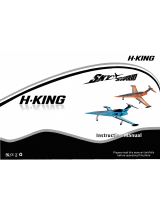
EN
HABU STS
6
Transmitter
Antenna
A Switch
(Ch 5 Default)
D Switch
(Ch 7 Default)
RGB LED
Flight Battery
Voltage Indicator
Throttle/Rudder
Gimbal
Power Button
Throttle Trim
Rudder Trim
Neck Strap Mount
H Switch
(Throttle Cut Default)
F Switch
(Dual Rate Default)
Elevator/Aileron
Gimbal
Elevator Trim
Aileron Trim
Handle
Wireless Trainer
Port
Programming
Port
Battery Holder
I Button
(Channel 6 Default)
Installing the Transmitter Batteries
Your Spektrum DXS Transmitter comes prebound to the aircraft.
Remove the battery cover, install the four included batteries (noting proper
polarity) and reinstall the battery cover.
Low Battery Alarm
When the transmitter battery voltage drops below 4.7 volts, an alarm sounds
and the voltage LEDs flash. The batteries must be replaced immediately. If this
happens while flying, land your aircraft as soon and as safely as possible.
CAUTION: If using rechargeable batteries, charge only rechargeable
batteries. Charging non-rechargeable batteries may cause the batteries
to burst, resulting in injury to persons and/or damage to property.
Transmitter Features
Explanation of DXS Transmitter LEDs, Switches
and Modes for the Habu STS.
Trainer/Bind/Panic Button (I button):
This switch is used as both the trainer and bind switch as well as the Panic
Switch for your Habu STS. For complete binding instructions, refer to the binding
section below. When using the trainer function, connect the SRXL2 DSMX remote
receiver (SPM9747, sold separately) into the wireless trainer port of the master
(instructor) transmitter. The master transmitter must be powered ON and bound
to the aircraft receiver. The slave transmitter must be powered OFF. Any time you
press and hold the trainer button on the master, it will give control authority to
the slave. Releasing the trainer button returns control to the master.
IMPORTANT: The slave transmitter must always have the same settings as the
master. See Flight Training section for setup of other Spektrum Transmitters.
Hi/Lo Rate Switch (F Switch):
This switch supports high and low rate functions on aileron, elevator and rudder
channels. In the upper, or “HI” position, servo travel is 100% on these channels.
In the lower, or “LO,” position, servo travel decreases to 70%. This switch lets
you quickly change control rates from high for aggressive maneuvers to low for
smooth, precise maneuvers. When learning to fly, use low rate.
Flight Mode Switch (A Switch):
This switch is used to select the SAFE Flight mode. For other conventional
receivers, this switch controls a servo connected to the Channel 5/Gear port.
RGB LEDs:
Flashing with beeps- Bind mode when Trainer (Bind) switch is held and the
transmitter is powered on (see Binding instructions).
Pulsates with one low tone beep every 2 seconds (when transmitter battery
voltage drops below 4.7 volts). Replace the transmitter batteries immediately. If
this happens while flying, land your aircraft as soon and as safely as possible.
Battery Voltage Level
The included DXS transmitter includes a new flight battery voltage level
indicator feature.
LED SMART Battery voltage indication is based on current voltage and will
change with throttle/power usage. When throttle is increased, voltage drops,
causing the bars to indicate lower power (e.g., fewer LEDs solid or flashing.)
When the throttle is lowered to idle/off, the bars recover (e.g., more LEDs solid
or flashing). LED bars will rise and lower depending on throttle/power usage.
The SMART Battery low voltage alarm sounds when the ESCs are close to
reaching low voltage cutoff. The alarm will sound for 25 seconds. If the throttle
is lowered to allow voltage recovery, the alarm will stop early. Land the aircraft
when the alarm sounds.
After landing, reset the SMART Battery low voltage warning by either (1)
powering cycling the DXS transmitter, or (2) disconnecting the battery from the
aircraft for more than 15 seconds or until the LED voltage indication bars
go out.
Connect a fully charged battery to the aircraft, which will ensure the SMART
Battery low voltage warning resets prior to the next flight.





















